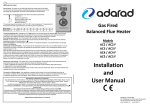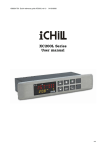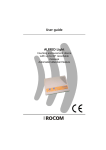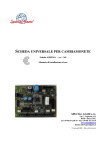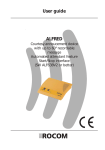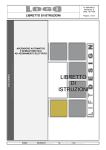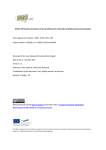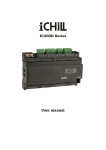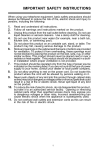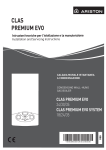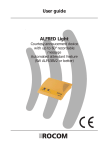Download MANUALE
Transcript
TEM11 1111 MANUALE DI ISTRUZIONI / USER’S MANUAL CARATTERISTICHE GENERALI: Il TEM11 è un regolatore elettronico digitale di temperatura formato 48 x 48 progettato per funzionare, alternativamente, in tre modalità diverse: regolazione PID, ON/OFF, AUTOTUNING e SELF TUNING. Su richiesta l’apparecchio può essere provvisto di contatto di allarme supplementare. L’utente può inoltre variare i parametri interni del TEM11 direttamente dal quadro comandi, personalizzando la modalità di lavoro. Il frontale del TEM11 comprende: un display da ½” a tre cifre, tre tasti per la programmazione, un led che indica l’attivazione della termoregolazione, un led che indica la chiusura del contatto di allarme. TECHNICAL SPECIFICATIONS: The TEM11 is a microprocessor temperature control device. Its size 48 X 48mm follows the 43700 DIN provision. You can select three different methods of working: PID, ON/OFF AUTOTUNING and SELF TUNING. A special version of TEM11 is equipped with an alarm contact. In every device you can change the internal parameters from its keyboard. The frontal of the TEM11 shows: one ½” three-digit number display, a keyboard composed of three switches, one termoregulation starting-up LED indicator and one fastening alarm contact LED indicator (only for the special version). DIMENSIONI ED INGOMBRI (DIMENSIONS AND OVERALL LAYOUT): 71 48 48 45 45 96 SPECIFICHE TECNICHE ( TECHNICAL SPECIFICATIONS): ALIMENTAZIONE - power supply ASSORBIMENTO - electrical absorption INGRESSI inputs USCITE outputs RETROAZIONE - feedback TEMPERATURA DI ESERCIZIO - working temperature CONTENITORE - case dimensions PESO - weight 24 DC - 24 /115 /230 VAC 50 / 60 Hz. ± 10 % 2 VA termocoppie - thermocouples (J- K) termoresistenze - thermal resistance ( RTD- PT100) a relè (carichi resistivi 3A 240V ) with relay ( resistive load 3A 240V) per SSR 12 VDC 15 mA PID - ON/OFF - auto-tuning e self tuning 0……….50 °C ABS autoestinguente VO ABS self-extinguishing circa approx. 200 gr. COLLEGAMENTI ELETTRICI (ELECTRIC CONNECTIONS): 7 8 4+ 5 1 2 3 6 ALIMENTAZIONE POWER SUPPLY termocoppie (J -K) termoresistenze ( RTD – PT100) OUT AL uscita relè 3 A 240v ( 1…..…2 ) SSR 12 vdc 15 mA ( 1+…..2- ) contatto di allarme uscita relè 1 A 240V uscita a SSR 12 vdc 15 mA ( 3+…..6- ) thermocouple thermal resistance OUT AL (J - K) ( RTD-PT100 ) relay contact 3A 240 v ( 1….……2 ) SSR output 12 vdc 15 mA ( 1+…..2- ) output alarm control relay contact 1 A 240V SSR output 12 vdc 15 mA (3+…..6- ) 1 IL TEM11 AL LAVORO (THE TEM11 ON WORK): Come accennato alla pagina precedente, l’apparecchio può lavorare in tre diverse modalità: As you can read on the previous page, the device can work in three different methods: 1. Regolazione P.I.D. : in questo caso il TEM11 regola la temperatura basandosi su particolari parametri impostati dalla casa costruttrice. Tale modalità viene preselezionata in fabbrica in quanto si adatta in modo ottimale alla maggioranza delle applicazioni previste. P.I.D. regulation: the TEM11 adjusts the tempearure by following special parameters wich have been planned in the home firm. In this way the TEM11 can excellently aswer to most of the owner’s requirements. Every device is sold with this specification. 2. Regolazione ON/OFF : l’apparecchio mantiene attivata la funzione riscaldante fino al raggiungimento della temperatura di set. E’ possibile inserire dei differenziali positivi o negativi modificando i paramentri interni del TEM11. ( vedi pag. 3) ON/OFF regulation: the device keeps on heating the temperature until it reach the set-point. You can plan positive or negative differentials by changing the internal parameters of the TEM11. (pg.3) 3. Regolazione con AUTOTUNING e SELF TUNING: La funzione di auto tuning e self tuning, permette al termoregolatore, mediante un ciclo di autoapprendimento, di calcolare automaticamente i parametri PID in base alle caratteristiche dell’elemento da dover riscaldare. Il TEM11 fornisce potenza massima fino al raggiungimento di una soglia intermedia tra temperatura attuale e set point (D), quindi attende che la temperatura del sistema raggiunga il primo picco. Al termine di questo ciclo vengono calcolati ed impostati i parametri PID ottimali per il processo osservato e lo strumento riprende la normale regolazione PID ottimizzata (M). The TEM11, by mean of the auto tuning and self tuning function, can adjust its internal parameters by itself. The TEM11 generates its maximum heating strenght until it reachs a middle temperature (D), then it stops the output. It analyses all the heat specifications of the object wich has to be heated. After the calculus the TEM11 adjusts its internal parameters and stores the correction. Finally it starts his work using an optimized PID regulation (M). (°C) TEMPERATURE: 0 : zero termico (zero degrees) B : temperatura ambiente (room temperature) A : temperatura di set ( set temperature) D : temperatura di inizio processo osservato M : temperatura di fine processo osservato (T) TEMPI (PHASES): 0 : accensione (start) T1: inizio processo osservato (observed phase start-on) T2 : fine processo osservato (auto tuning stop) inizio regolazione PID ottimizzata (optimized PID regulation) La funzione di autotuning si seleziona modificando i parametri interni dell’apparecchio (vedi manuale di istruzioni). E’ importante tuttavia che tale operazione venga eseguita a temperatura ambiente o macchina fredda. You can select the autotuning method by adjusting the internal parameters of the TEM11 using its keyboard. This operation must be done when the machine is cold at room temperature. 2 Impostazione della modalità ON/OFF: ( Par. 08 = 0 ) La funzione ON/OFF si attiva impostando la cifra 0 nel parametro 08. Il differenziale minimo impostabile è di 1°C. Tale variabile può essere modificata agendo nei parametri 13 e 14. Nel parametro 13 impostare un valore di differenziale positivo + ; nel parametro 14 uno negativo –. Il contatto del relè resterà eccitato (ON) fino al raggiungimento del valore del differenziale positivo; resterà diseccitato (OFF) fino al raggiungimento del valore del differenziale negativo. ON-OFF DEL SET Par – 13 - differenziale positivo ( + ) del set diff. diff. — + Par – 14 - differenziale negativo (—) del set SET POINT You can select the ON/OFF method by setting the “0” number in the “08” parameter. You can plan positive or negative differentials (for a minimum of 1°C) by adjusting “13” and “14” parameters. If you plan a positive differential in the “13” parameter and a negative differential in the “14” parameter the alarm contact will be fastened until it reachs the positive border line to will be opened until it reach the negative border line. Allarme assoluto ( indipendente dal set): ( Par. 02 inserire valore ) Questa funzione di allarme ESCLUDE qualunque riferimento con il set. Si può impostare un valore assoluto ed eventualmente porre un limite impostando nel parametro 10 il valore del limite superiore al set ,al parametro 11 se inferiore al set. In entrambi i casi la funzione del relè di allarme può lavorare nei seguenti modi: parte da eccitato ( ON ) inserire 2 nel parametro 07 ; parte da diseccitato ( OFF ) inserire 1 nel parametro 07. SET POINT The “absolute alarm” function has not relations with the set temperature. You can plan an absolute alarm and eventually set a borderline. You can set a higher value by adjusting “10” parameter or set a value below by adjusting the “11! Parameter. The alarm contact can work by following two different methods: it can start being fastened (you must set “2” number in the “07” parameter) or it can start opened (you must set “1” in the “07” parameter”. Allarme legato al SET (deviazione o finestra) ( Par. 12 inserire 2 ) Questa configurazione di allarme chiamata comunemente di deviazione, finestra o zona neutra, permette al contatto del relè di lavorare a cavallo del set in modo eccitato ON oppure diseccitato OFF. L’apparecchio permette l’impostazione di due differenziali diversi fra loro programmabili sopra o sotto il set. Per esempio: This configuration is usually called “window alarm”. In this way the alarm contact has a relation with the set temperature. You can set positive or negative differentials. For example: OBIETTIVO: Con un set di 100 °C si desidera avere un allarme fissato a 15 °C oltre il set e 20 °C sotto il set. TARGET: Set temperature: 100°C. You want to fix the alarm at 15°C higher than set and 20°C below the set. PROCEDURA: impostare nel parametro 10 il differenziale 15 (positivo +) ; nel parametro 11 il differenziale 20 (negative –). PRACTICE: You have to set the “15” positive differential in the “10” parameter (+); you have to set the “20” negative differential in the “11” parameter. L'allarme funzionerà tra 80 e 115 °C. So the alarm will activate between 80°C and 115°C. Se tra 80 e 115 si desidera una funzione ON impostare 3 nel parametro 07. Se OFF impostare 4 nel parametro 07. If you set the “3” number in the “07” parameter you will activate the ON function; if you set the “4” number in the “07” parameter you will activate the OFF function. Par. 07 – ( 4 = OFF) (3 = ON ) Par.10 – differenziale positivo (+) oltre il set Par.11 – differenziale negativo (—) sotto il set diff. — diff. + SET POINT 3 Regolazione dell’ OFFSET ( Par. 09 ) L’operazione permette di adeguare e visualizzare sul display la temperatura ottimale di lavoro, che tiene conto della differenza tra la temperatura rilevata dalla sonda e quella misurata manualmente. • Il display visualizzerà la cifra “50”, che corrisponde ai gradi (°C) modificabili. • Aumentare ( se la temperatura riscontrata è superiore a quella letta dalla sonda). • Diminuire ( se la temperatura riscontrata è inferiore a quella letta dalla sonda). OFFSET regulation: If you discover a difference between the display temperature and the real temperature the TEM11 can display the optimal working temperature wich considers that difference ”. The display will indicate the “50” number (it indicates the °C wich can be changed). You must: • Step up ( if the real temperature is lower than display temperature). • Step down (if the real temperature is higher than display temperature). PROGRAMMAZIONE della TEMPERATURA: Ad alimentazione inserita i display visualizzano la cifra “888” (diagnosi e comunicazione di buon funzionamento), poi la temperatura rilevata dalla sonda. Per variare il set point agire nel seguente modo. 1 Premendo il tasto S il display inizia a pulsare, poi visualizza la temperatura di default. If you press the S switch the display will pulse; the it will indicate the default temperature. 2 Led (OUT) Il led di sinistra (OUT) si accende quando il contatto relè di lavoro è CHIUSO. It indicates the fastening of the working contact relay. Per variare la temperatura di lavoro agire sui tasti di sinistra. You can change the working temperature by using the left switches. Il TEM11 è programmato. I valori impostati vengono memorizzati automaticamente dopo due secondi dal termine della digitazione. The TEM is now ready to work. It sores your selected values by itself. Led (AL) Il led di destra (AL) si accende quando il contatto di allarme è CHIUSO. It indicates the fastening of the alarm contact. ATTENZIONE/WARNING: Se il display visualizza la cifra “111” ed inizia a pulsare ciò indica che la temperatura è in over range o che la sonda non è collegata. If the display indicates “111” it will mean that the probe is not connected or the temperature is overrange. SUGGERIMENTI PER L'INSTALLAZIONE (SETUP RULES) Collocare il TEM11 lontano da carichi fortemente induttivi che possono emettere disturbi elettromagnetici di notevole rumore ( grossi teleruttori di potenza, motori, relè etc.).Separare i cavi della sonda da quelli dell’alimentazione. Don’t place the TEM11 near heavily inductive loads. Separate each power wire. CODICI PER L’ORDINE ( ORDER CODES): TEM11 °C 600 999 300 sonda J k RTD (PT100) alimentazione 24 VAC 24 VDC 115 VAC 230 VAC uscita (OUT) 1 SSR 2 Relè allarme (AL) 1 Relè 2 SSR 4 COME ACCEDERE AI PARAMETRI INTERNI PROGRAMMABLE VARIABLES ACCESS TO PARAMETERS L’apparecchio viene fornito con dei parametri standard che tuttavia possono essere modificati. Per accedere alla variazione degli stessi, procedere come segue: Tenere premuto il tasto S per circa 8 secondi. Il display visualizza la temperatura di lavoro e se prevista, la temperatura di allarme; dopo visualizza 0 3 seguito dal numero 100. Con i tasti t u digitare il codice 123 premere il tasto S e si accede ai parametri della tabella dal numero 3 – 1 al numero 16. Eseguite le varianti l’apparecchio dopo circa 8 secondi uscirà dalla programmazione. Il display flash “ 9….9 “ = varianti memorizzate. N.B. i parametri 02–07–10–11-12 saranno visualizzati solo se è previsto il contatto di allarme. The device standard parameter can be modified following the hereunder instructions: -press the S button for about 8 seconds, the display will indicate the working temperature and- if foreseen the alarm temperature, then the number 100. Digit the 123 default code by means of the t u buttons and press the S button in order to access from the 3-1 up to the 16 parameters. The new programming will be set off after about 8 seconds. The display flash “9…9” “variants in memory”. The display will indicate the parameters n° 02 – 07- 10 – 11 and 12 only if foreseen with an alarm contact. CODES RANGE FLASH 1- 999 20 DEFAULT DESCRIZIONE DESCRIPTION set temperatura lavoro / setting of the working temperature 0 2 1- 999 100 allarme settabile / setting value of the alarm contact 0 3 ==== 123 codice chiave di accesso / parameter password and code 3-1 00 /01 00 00= 3-2 00 /01 00 0 0 = DEFAULT 0 4 1 -999 401 blocco limite del set / bloking of the max setting limit 0 5 2 - 25 15 tempo ciclo relè / relay cycle time 0 6 1 -999 120 tempo integrale 0 7 1-4 1 0 8 0- 400 20 banda proporzionale 0 9 1 -100 50 regolazione 1 0 1- 999 600 1 1 0- 999 0 allarme settabile negativo oppure : / set down alarm or differenz. negativo con allarme legato / differential down whit unit alarm 1 2 1-2 1 (1) allarme settabile - set alarm 1 3 0- 999 0 differenziale positivo del set (on/off ) / differential up (on/off ) 1 4 1- 999 1 differenziale negativo del set (on/off) / differential down (on/off) 1 5 1-2 1 (1) °C gradi - degrees centigrade / (2) °F 1 6 0- 999 0 (0) = modalita’ ECO ESCLUSA - da 1…..a 999 (°C ) = modalita’ ECO INCLUSA NO AUTOTUNING / 01= SI AUTOTUNING 01= RIPRISTINO DEFAULT integral time allarme assoluto settabile (1-off/ 2-on ) finestra o deviazione (4-off / 3 -on) Set absolute alarm (1–off / 2 on) window alarm device (4-off / 3 -on) OFFSET ( 0 = ON/OFF) / / proportional time OFFSET allarme settabile positivo oppure / set up alarm or: differenziale positivo con allarme legato / differential up whit unit alarm (2) allarme legato al set unit set alarm - fahrenheit 5 TEM11 SPIEGAZIONE E FUNZIONE “ ECO ” L’apparecchio TEM11 è un regolatore di temperatura con tutte le funzioni di processo configurabili standard. Dispone inoltre di una funzione denominata ECO e serve per dare all’utente la possibilità di abbassare la temperatura di lavoro nei momenti di pausa prolungata, senza necessariamente spegnere la macchina ma mantenendola sempre in temperatura “ bassa” di un valore che si vuole, ma inferiore a quello del set. E’ sufficiente infatti inserire un numero in gradi (°C) dentro la tabella parametri (par.16 ) e l’apparecchio abbassa la temperatura solo dei gradi impostati. L’attivazione della funzione “ ECO” avviene premendo per circa un secondo ed in qualunque momento , i due tasti dell’apparecchio ▲ ▼. La disattivazione avviene premendo gli stessi tasti. COME SI PROGRAMMA LA FUNZIONE “ ECO ” - Entrare nel parametro 16 (vedi manuale pag. 6) ed impostare un numero relativo ai gradi che si desidera abbassare e che la funzione ECO se inserita, sottrae alla temperatura di SET. Esempio: se come SET di temperatura si imposta 150 ° C e nel parametro “ 16 ” si impostata “ 30 ”, la funzione ECO (se inserita), abbasserà la temperatura del set fino a 120 ° C con display lampeggiante. Non appena manualmente la si disinserisce, tornerà al valore di SET impostato 150 ° C. - Per inserire la funzione ECO durante la sessione di lavoro, occorre premere contemporaneamente i tasti ▲ ▼ fino a quando i display non iniziano a pulsare. - Per disinserire e riprendere il ciclo lavorativo normale, occorre premere nuovamente i tasti ▲ ▼ fino a quando il display non torna alla visualizzazione fissa. - La modalità ECO si attiva, solo entro 5 gradi dal raggiungimento della temperatura impostata nel SET. - Se nel parametro 16 si imposta “ 0 ″, la funzione ECO non viene attivata e lavora come un normale termoregolatore. l’apparecchio - La funzione ECO non modifica in alcun modo i parametri di set e di allarme impostati precedenza dall’utente. in - La funzione ECO viene riconosciuta dal continuo lampeggio dei tre display. Il valore della funzione ECO non può essere superiore al valore di set, viene disinibito automaticamente dal programma. srl via G. della Casa 2 – 20151 Milano tel. 02/30.84.452 fax. 02/33.40.40.90 e-mail- [email protected] www.bebmilano.it 6






